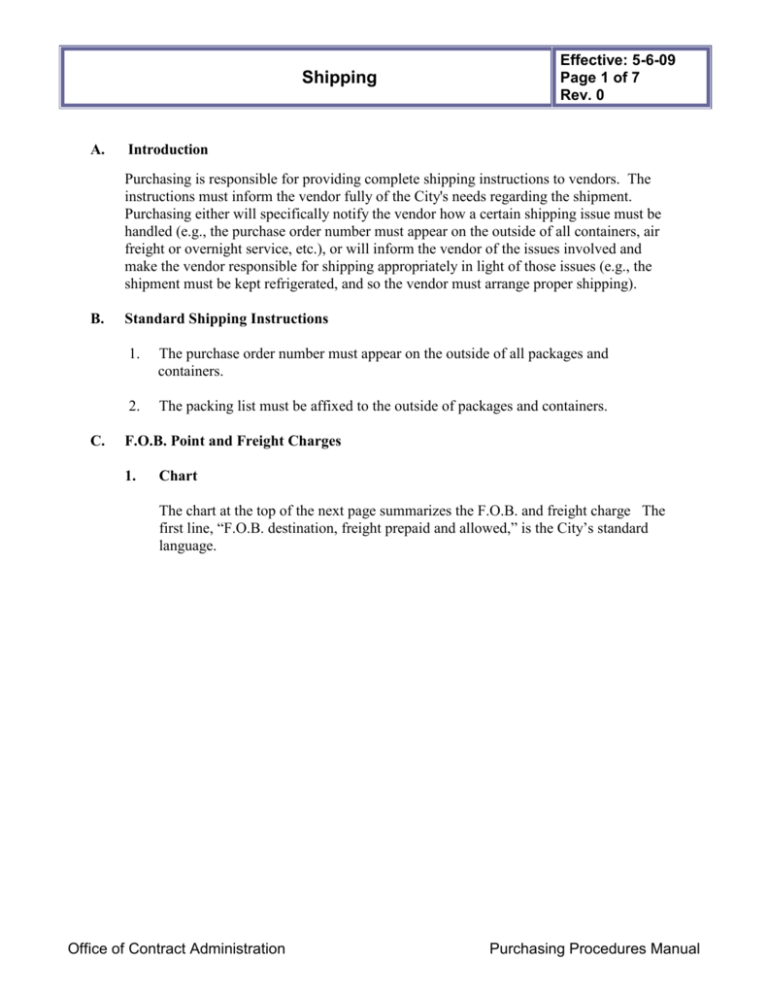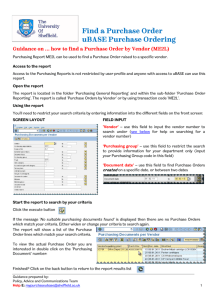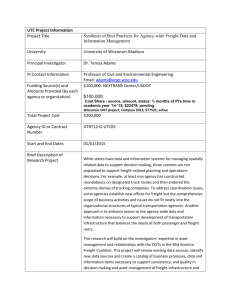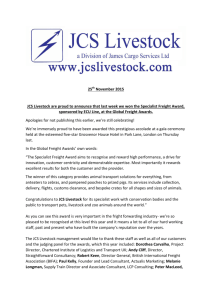A. Introduction
advertisement

Shipping A. Effective: 5-6-09 Page 1 of 7 Rev. 0 Introduction Purchasing is responsible for providing complete shipping instructions to vendors. The instructions must inform the vendor fully of the City's needs regarding the shipment. Purchasing either will specifically notify the vendor how a certain shipping issue must be handled (e.g., the purchase order number must appear on the outside of all containers, air freight or overnight service, etc.), or will inform the vendor of the issues involved and make the vendor responsible for shipping appropriately in light of those issues (e.g., the shipment must be kept refrigerated, and so the vendor must arrange proper shipping). B. C. Standard Shipping Instructions 1. The purchase order number must appear on the outside of all packages and containers. 2. The packing list must be affixed to the outside of packages and containers. F.O.B. Point and Freight Charges 1. Chart The chart at the top of the next page summarizes the F.O.B. and freight charge The first line, “F.O.B. destination, freight prepaid and allowed,” is the City’s standard language. Office of Contract Administration Purchasing Procedures Manual Effective: 5-6-09 Page 2 of 7 Rev. 0 Shipping Option F.O.B. destination, freight prepaid and allowed F.O.B. destination, freight included F.O.B. destination, freight collect and allowed F.O.B. destination, freight collect F.O.B. Origin, Freight Included (also termed Freight Allowed Destination, or Full Freight Allowed) F.O.B. Origin, Freight prepaid and charged back F.O.B. origin, freight collect and allowed F.O.B. Origin, freight collect 2. Who ultimately pays Who pays the carrier the freight Supplier City Who owns the goods, bears risk of loss, and files damages claims Supplier Supplier Supplier Supplier City Supplier Supplier City City Supplier Supplier Supplier City Supplier City City City Supplier City City City City F.O.B. (Free on Board) a. Definition F.O.B. stands for "Free on Board." The F.O.B. point is the point at which ownership of the goods and risk of loss pass from the seller to the buyer. Along with ownership and risk goes the responsibility for filing claims with the carrier for any damage in transit. The two most important F.O.B. options are "F.O.B. Destination" and "F.O.B. Origin." Less commonly used is "F.O.B. Plant." b. F.O.B. Destination This is the City’s preference in most cases. With F.O.B. Destination, the City does not own the goods until they arrive. The City would not have to pay the vendor for goods lost or damaged in transit, because the City did not own them Office of Contract Administration Purchasing Procedures Manual Effective: 5-6-09 Page 3 of 7 Rev. 0 Shipping when the damage occurred. F.O.B. Destination also usually means that the vendor pays all shipping costs. Depending on the vendor's bid, the vendor may absorb the costs by stating that the bid price included shipping, or could prepay them and add them to the invoice. This implication can be overridden by specific language relating to those costs, and the Purchase Order's "freight prepaid and allowed" authorizes the vendor to pay the shipping costs and add them to its invoice. For information on freight charge provisions, see paragraph 2, "Freight Charges," below. c. F.O.B. Origin Purchasing avoids F.O.B. Origin if possible. F.O.B. Origin makes the City the owner of the goods from the time they leave the vendor's place of business, or when they leave a distribution point near the vendor if one was used. If a vendor delivers the goods to its local freight terminal, the goods become the City's when they leave the terminal. F.O.B. Origin also implies that the vendor pays shipping to the terminal and the City pays from the terminal to the City. d. F.O.B. Plant F.O.B. Plant shifts the title, risk, and responsibility to the City when the goods leave the vendor's place of business to go to a freight terminal and then on to the City. F.O.B. Plant is a term encountered infrequently. 3. Freight Charges a. Freight Prepaid and Allowed; or Freight Included The Purchase Order states "freight prepaid and allowed," which means the vendor pays the shipper and adds the shipping charges to the vendor's invoice. If the vendor will include shipping charges in the unit price of the goods, this is "freight included" or "freight prepaid." b. Freight Prepaid and Added; or Freight Prepaid and Charged Back This means essentially the same as freight prepaid and allowed, but is the terminology used when the order is F.O.B. origin rather than F.O.B. destination. c. Freight Collect "Freight collect" means the City will pay the carrier directly for freight charges. The carrier later invoices the City by sending the invoice to Purchasing. Freight collect refers only to freight charges, and not to the shipment's line item Office of Contract Administration Purchasing Procedures Manual Shipping Effective: 5-6-09 Page 4 of 7 Rev. 0 prices. Compare "C.O.D" in §f below. To pay a freight bill, the requesting department must submit a Direct Voucher (DV) to Purchasing. The carrier's invoice cannot be processed as part of the purchase order because there is a second payee. d. Driver Collect Some carriers will stamp "Driver Collect" on a freight bill, and this instructs the driver to collect the freight charges from the City when delivering the shipment. The City has no mechanism for paying carriers at time of delivery. The requesting department informs the driver that the City will process the freight bill normally and the carrier will be paid by the Controller later. e. Freight Collect and Allowed Under "freight collect and allowed," the City would pay the carrier upon delivery, but deduct the amount paid from the vendor's invoice. Ultimately, the vendor bears freight costs, but the City still has the significant problem of having to pay the carrier on the spot. Purchasing does not agree to this variation on freight collect. f. C.O.D. (Cash on Delivery) If a shipment were C.O.D., the City would be obligated to pay the vendor's invoice when the carrier delivered the goods. C.O.D. shipments violate the City procedures regarding payment only after departmental receipt and acceptance, and only after department matches the invoice to the purchase order. Purchasing never agrees to C.O.D. terms, and the requesting department refuses any C.O.D. shipment. C. Methods of Shipping 1. General It is the vendor's responsibility to select an appropriate method of shipping an item from the supplier's location to the City's final delivery point. Purchasing usually gives the vendor no instructions on how to ship. This section reviews available shipping methods and notes when they would be important for a particular delivery. If Purchasing gives the vendor any specific instructions to the vendor as described in the following paragraphs, the instructions would be made first by telephone and then included on the purchase order. Office of Contract Administration Purchasing Procedures Manual Shipping Effective: 5-6-09 Page 5 of 7 Rev. 0 For unusual shipping methods, particularly water and rail, the purchaser should work closely with the department to make sure responsibilities, shipping notification, delivery instructions and transfer of title are clearly stated in the PO. 2. Air Purchasing specifies air freight if the item is needed urgently, but asks the vendor for an estimate of the freight charges. If the charges are unexpectedly high, Purchasing calls the requesting department to ascertain whether air freight is still desired. 3. Surface (truck) Unless Purchasing requests otherwise, vendors most often ship by truck, usually via UPS. 4. Rail Rail shipments can be cheaper but slower than truck shipments. Some items too heavy for standard long-distance trucks must go by rail. As needed, the buyer consults with the vendor on the advisability of shipping by rail. If a shipment is so heavy that it will be shipped by rail, Purchasing asks the vendor to arrange with a local drayage company for delivery from the rail terminal in San Francisco to the final delivery point. The vendor pays the drayage company and adds those costs to the vendor's invoice to the City. 5. U.S Postal Service Vendors rarely ship packages via the Postal Service, preferring to use common carriers instead. Tracing lost shipments can take longer if the shipment was mailed, unless it was sent Certified Mail. 6. Water Unusually heavy or bulky items could be shipped by water rather than by rail. Arrangements with a drayage company would be required. If the purchase is funded by the federal government (UMTA or its successor, the RTA), the purchase order attachment requires water shipments to be made in U.S. flag vessels. Office of Contract Administration Purchasing Procedures Manual Shipping D. Effective: 5-6-09 Page 6 of 7 Rev. 0 Specialized Shipping Instructions 1. General The vendor is generally responsible for shipping items in an appropriate manner. This section reviews unusual situations where Purchasing gives the vendor specific instructions, or the vendor does something out of the ordinary, or both. If Purchasing gives the vendor any specific instructions as described in the following paragraphs, the instructions would be made first by telephone or e-mail and then included in the Purchase Order. In any unusual situation, the purchaser works with the user department to ensure that all important issues are clearly communicated among Purchasing, the department, the vendor and if necessary to freight company. 2. Inside delivery The City’s preference is almost always for delivery to be made inside the building. Unless otherwise directed, a common carrier will deliver a small item (that can be hand-carried) to a delivery point anywhere in a building, but will deliver a large or heavy item only to the loading dock or sidewalk. If Purchasing knows that the item is bulky, for example, and that the delivery point is on the third floor of a building with no elevator, Purchasing indicates on the purchase order: "Final delivery to Room 323; building has no elevator." 3. Weight Unusually heavy shipments may require special trucks, or may have to go by rail where appropriate. If a common carrier will not deliver the item to the final delivery point, Purchasing instructs the vendor to make appropriate arrangements with a local drayage company which will in turn deliver to the department. Such local companies have special loading equipment, such as hoists, lifts, etc., which the City does not possess, and use the specialized equipment to load the shipment onto the local companies' own trucks, and in turn deliver to the department. Purchasing asks the vendor to pay the drayage company and to include those costs on the vendor's invoice to the City. When placing the order with the vendor, Purchasing also informs the local company of the purchase order number for the transaction, and instructs the local company to submit its invoice, which is a freight bill, to the requesting department. Office of Contract Administration Purchasing Procedures Manual Shipping 4. Effective: 5-6-09 Page 7 of 7 Rev. 0 Hazard Items such as chemicals may be hazardous and must be shipped safely. The vendor is responsible for arranging for appropriate shipping which conforms to all governmental regulations. A Material Safety Data Sheet (MSDS) is required for all deliveries, and a statement to that effect is included in all purchase orders. E. Insurance Insurance is available from several sources to cover possible damage to goods during shipping. Many carriers include insurance automatically in their rates for the first $100 of a shipment's value. For higher insurance coverage, the vendor must notify the carrier. Usually carriers do not offer insurance for shipments over $500, and require that the vendor present evidence that the shipment is insured. Office of Contract Administration Purchasing Procedures Manual






